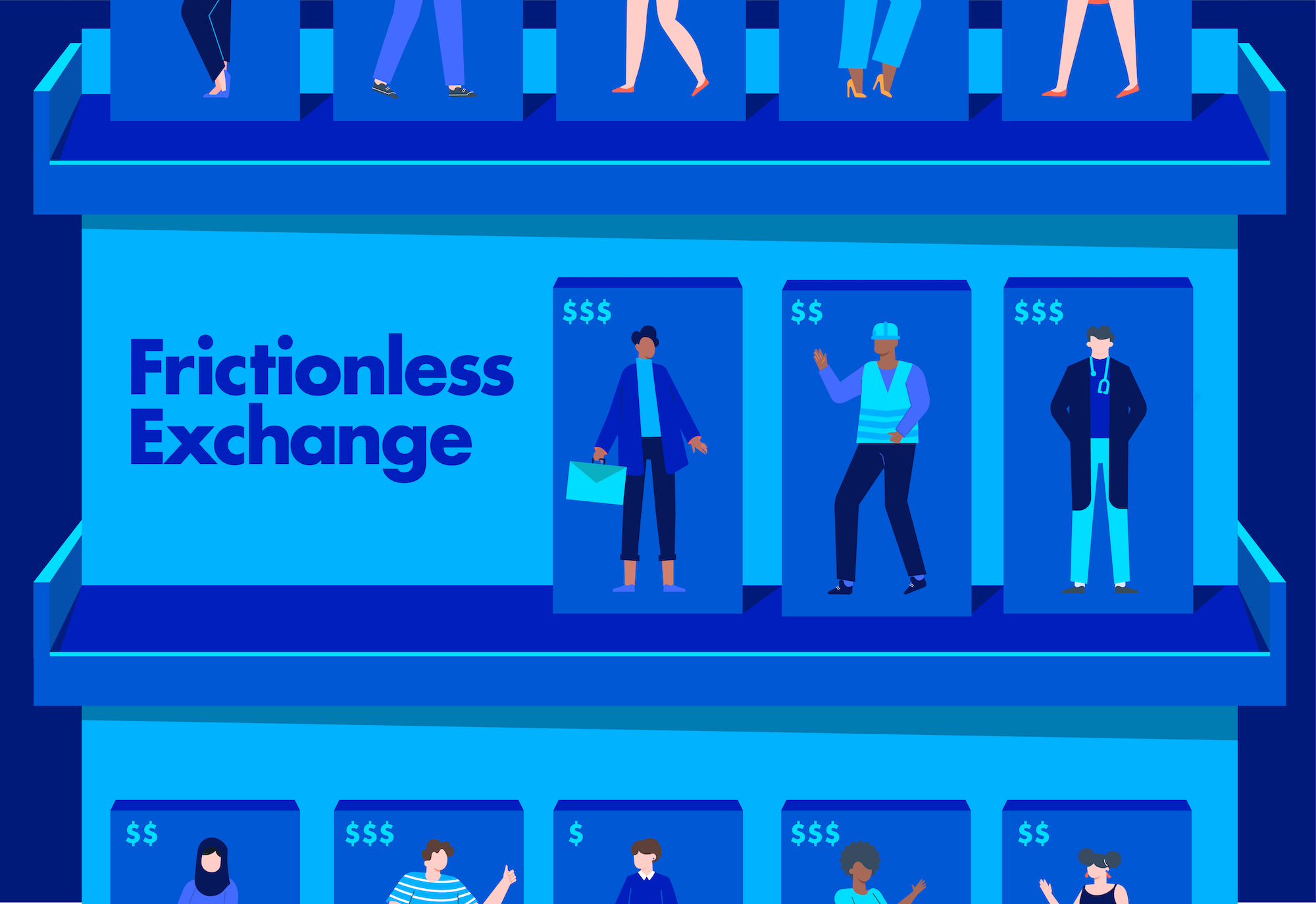

What happens to markets as the digital age improves their efficiency and introduces them to new domains?
RECOMMENDED READING
Markets are complex institutions that rely on formal rules and informal norms as well as complementary institutions and infrastructure to facilitate mutually beneficial exchanges. Those exchanges themselves create value in various ways—not only the tangible trade of something that one person considers more valuable for something that the other prefers but also the relationships created and information generated in the course of transacting and the future commitments made.
The Information Era has revolutionized existing markets and extended the market mechanism to new domains by reducing or eliminating barriers to entry and transaction costs, allowing buyers and sellers to find each other, negotiate, and conclude their exchanges with once-unimaginable efficiency. The benefits are enormous: cheaper, better, and more tailored products; greater competition and faster innovation; new opportunities for entrepreneurs and greater convenience for consumers. But greasing the gears of commerce to whirl unimpeded, in the process sweeping aside the norms and institutions and relationships often taken for granted, has costs as well. Prosperity requires markets to deliver a society enough efficiency and disruption to produce growth but not so much as to risk disintegration.
This tension becomes most apparent when the market mechanism extends beyond the traditional realm of goods and services. The faster and easier the buying and selling of car parts the better, generally speaking. But as human nature and nonmarket concerns play a larger role, the picture becomes more complicated. An online dating app, for instance, matches people who might otherwise never have found each other. As a result, though, they will tend to lack the shared connections or social circle to ensure accountability for their treatment of each other. Access to all manner of pornography at the click of a mouse eliminates all the steps in the procurement process whose obstacles and limits may well have had social value. Renting one’s house as a hotel each weekend provides income—but, if everyone does it, there goes the neighborhood.
The most economically significant of these markets is the labor market, in which people’s time and effort are the objects of exchange and prices are the wages that they rely upon to support their families. The Information Era has upended some facets of the labor market already and stands poised to reach into many others. How novel is this change? And to what extent should public policy respond?
Conditions of Employment
The Information Era has transformed the employment experience at almost every stage, beginning with the job-search process. Employers increasingly rely upon a centralized hub like Glassdoor, Indeed, or ZipRecruiter, which listed nearly 15 million U.S. job openings as of March 2021. (For reference, the Bureau of Labor Statistics reported a total of 8.1 million job openings and 6.0 million hires the same month.) These services automatically extract résumé data, score applications, and cull candidates for a human hiring manager to review, but the responsible algorithms are necessarily selective and dependent on keywords and heuristics that often filter out those with unconventional work histories or those without a degree.
Workplaces themselves are increasingly “fissured,” with functions from building maintenance and food service to advertising and accounting more likely to be provided by outside firms and even workers occupied in core functions like engineering or sales often treated as independent contractors rather than full-time employees. Google now employs nearly 20% more independent contractors than standard workers. Over the last decade, the number of temps, independent contractors, and freelancers grew by 6 million, half of which reflects a shift away from traditional employment. In a 2018 NPR/Marist poll, 20% of employed Americans described themselves as “contract workers”; while they were less likely to say that their income stays mostly the same from month to month or that they receive health or retirement benefits, they were more likely to say that their employer values the work they do a great deal. According to the Bureau of Labor Statistics, “contingent workers” (which it defines as independent contractors, on-call workers, temporary help agency workers, and workers provided by contract firms) would prefer “noncontingent” to “contingent” work by roughly two to one.
In some sectors, managers use sophisticated scheduling tools to optimize the time of traditional employees, varying work hours to meet demand from week to week and asking workers to be available even when not on the clock. More than one-third of low-wage food and retail workers work a variable schedule, facing anywhere from a 33% to a 50% swing in hours week to week. Others are constantly collecting data on the activity and output of each worker to use for process improvement or performance assessment. WorkSmart software, for instance, takes periodic screenshots and monitors keystrokes and app usage to track performance. More encouragingly for workers, IBM has introduced systems that help workers take better advantage of training programs and that notify those with relevant skills of opportunities for promotion in other departments.
Employers do not yet fire workers via automated system, but Amazon has taken steps in that direction and, in fact, defended itself against an allegation of unfair termination by explaining that “the production system generates all production related warnings and termination notices automatically with no input from supervisors.”
The “Gig Economy”
Outside the traditional workplace, the Information Era has also supported the rapid growth of the “gig economy.” Gig work is nothing new; arguably, it predates now-typical forms of employment and wage labor by millennia. Absent the Internet’s emergence, no one would take much notice of the plumber, taxi driver, or lawyer who advertised his phone number in the yellow pages and awaited calls. What modern online platforms like Uber and TaskRabbit do is make the market for such labor much more market-like, commoditizing the service offered, allowing anyone to offer or purchase it with ease, and intensifying price competition along the way.
Despite their outsize role in discussions of economic trends, gig platforms remain a relatively small segment of the labor market. The Federal Reserve estimates that 16% of adults participated in “online activities” ranging from genuine gig work to selling things—a figure that, notably, rises with education level. Polling from Pew Research adds depth to these figures, indicating that selling things online is more common than finding work online, and, even in the latter category, the most common activity is taking surveys; only 2% of respondents reported work in “ride hailing” and 1% in “shopping/delivery.” This aligns with data from a 2018 study of bank-account activity by JPMorgan Chase, which found that 1.6% recorded online-platform activity in a given month (a fourfold increase over five years).
How much participants earn can be more difficult to discern. Estimates range widely, partly because of limited disclosures from platform operators and methodological differences in accounting for the costs of, say, operating a vehicle. TaskRabbit reports that its workers earn an average wage of $35 per hour. Recent studies of Uber and Lyft drivers have estimated earnings of $16–$21 per hour (before expenses) or $9 per hour (after expenses), at which point roughly half were earning more than minimum wage. Workers set their own rates and choose their own jobs on some platforms; on others, their rates are set and tasks are assigned by algorithm. In those cases, students of the system have concluded that the platforms actively manipulate their engagement, and some have sought ways to game it. Very few drivers report driving full-time, saying that they instead see the work as a way to supplement their income. Gig workers indicate that they value the flexibility offered by the platforms, and economic analysis has indicated that it provides them with significant value.
Market forces and technological advances are expanding the gig economy’s frontiers: in one direction, toward the heart of the traditional labor market; and in another, toward transactions that can be performed entirely online. In 2019, Uber launched “Uber Works,” which sought to partner with staffing agencies to match shift-workers with shifts, “for positions as diverse as being a prep cook, warehouse worker, a commercial cleaner or event staff.” The platform now appears defunct, and the introductory blog post links only back to Uber’s home page.
Amazon operates Mechanical Turk, a marketplace for the performance of discrete online tasks such as completing a survey or classifying a picture, which typically pay a dime or less and yield a median hourly wage below $2. But a wide range of jobs could potentially be recast in this manner, from the diagnostic work done by doctors to the testing and bug-fixing performed by software engineers. Managing such labor through online platforms also holds the prospect of further accelerating the trend in services toward a global labor market that has already occurred in the manufacturing sector, thanks to international trade.
Issues for Policymakers
The American regulatory framework for labor and employment was developed long before the Information Era and assumes that workers will fall into the clear categories of “employee” and “independent contractor.” Employees are expected to have established, often long-term, relationships with employers who, in turn, have the incentive to invest in training and retention and are able to provide ancillary benefits like health insurance and retirement savings. That relationship can be governed by straightforward regulations concerning issues like wages, hours, safety, and organizing. Independent contractors, by contrast, operate as businesses that interact with those who hire them as equals in the market for a product or service.
Whether and how to update this framework has been a focus of policymakers in recent years. They must decide whether it remains appropriate to the evolving forms of relationship between workers and firms, if some of those relationships are suspect and require curtailment, or if some new category is needed. In California, for example, lawmakers passed a bill reclassifying gig workers on app-based platforms as employees. But it has sparked backlash for threatening independent contractors’ flexibility and for inducing mass layoffs.
Policymakers must also consider whether an increasingly efficient labor market, less reliant on durable human relationships, eliminates vital supports that once buttressed workers. If so, new or modified forms of regulation could be required to achieve what market friction once ensured. For instance, a minimum wage for ride-sharing drivers, like the one introduced in New York City, could help to stabilize wages. Likewise, if the Information Era weakens workers’ ability to exert power in the market and find representation in the workplace, policymakers must decide whether to establish new mechanisms for countervailing that erosion. Organizations like the Freelancers Union have provided benefits and services to workers for decades, but existing labor law circumscribes the role that they can fill for worker representation and bargaining.
These same questions are relevant in other markets as well. Public policy supplements the natural constraints that market actors face. The disappearance of such constraints can be cause for celebration, but where policy in fact relied on their existence, policymakers face a new task.
Recommended Reading
How Technology Has Changed Our Jobs, Our Privacy, and Our Brains
American Compass research director Wells King discusses the wide-ranging effects of the digital revolution in an adaptation of Lost in the Super Market: Navigating the Digital Age.
Remaking the Modern Market
Gig workers deserve fair labor markets that private platforms cannot provide.
Calling on the Wrong Profession: Time to Listen Less to Economists
As hard as it is to believe, there was a time – before the New Deal – when economists were largely treated like any other interest group, occasionally saying something interesting, but usually ignored by policymakers.










